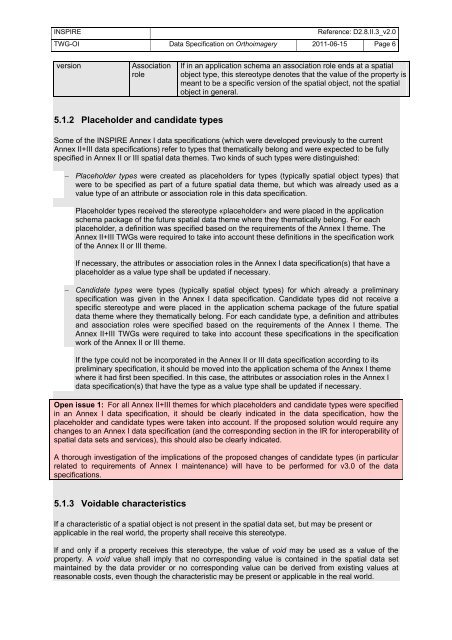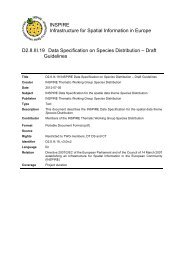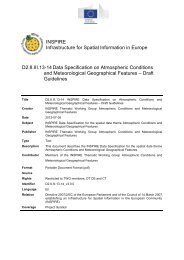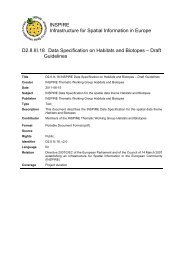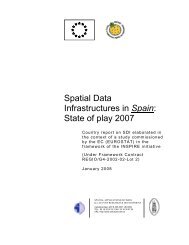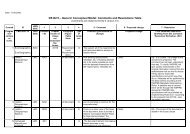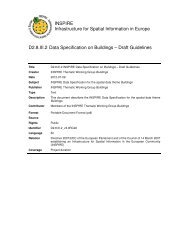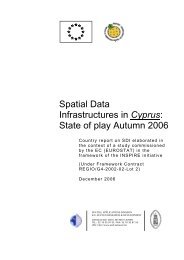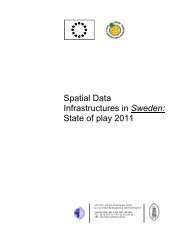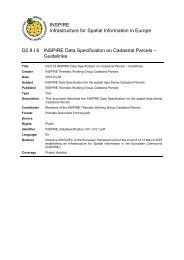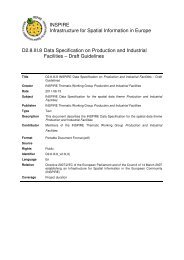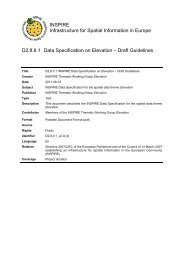Data Specification on Orthoimagery – Draft ... - INSPIRE - Europa
Data Specification on Orthoimagery – Draft ... - INSPIRE - Europa
Data Specification on Orthoimagery – Draft ... - INSPIRE - Europa
Create successful ePaper yourself
Turn your PDF publications into a flip-book with our unique Google optimized e-Paper software.
<strong>INSPIRE</strong> Reference: D2.8.II.3_v2.0<br />
TWG-OI <str<strong>on</strong>g>Data</str<strong>on</strong>g> <str<strong>on</strong>g>Specificati<strong>on</strong></str<strong>on</strong>g> <strong>on</strong> <strong>Orthoimagery</strong> 2011-06-15 Page 6<br />
versi<strong>on</strong> Associati<strong>on</strong><br />
role<br />
5.1.2 Placeholder and candidate types<br />
If in an applicati<strong>on</strong> schema an associati<strong>on</strong> role ends at a spatial<br />
object type, this stereotype denotes that the value of the property is<br />
meant to be a specific versi<strong>on</strong> of the spatial object, not the spatial<br />
object in general.<br />
Some of the <strong>INSPIRE</strong> Annex I data specificati<strong>on</strong>s (which were developed previously to the current<br />
Annex II+III data specificati<strong>on</strong>s) refer to types that thematically bel<strong>on</strong>g and were expected to be fully<br />
specified in Annex II or III spatial data themes. Two kinds of such types were distinguished:<br />
− Placeholder types were created as placeholders for types (typically spatial object types) that<br />
were to be specified as part of a future spatial data theme, but which was already used as a<br />
value type of an attribute or associati<strong>on</strong> role in this data specificati<strong>on</strong>.<br />
Placeholder types received the stereotype «placeholder» and were placed in the applicati<strong>on</strong><br />
schema package of the future spatial data theme where they thematically bel<strong>on</strong>g. For each<br />
placeholder, a definiti<strong>on</strong> was specified based <strong>on</strong> the requirements of the Annex I theme. The<br />
Annex II+III TWGs were required to take into account these definiti<strong>on</strong>s in the specificati<strong>on</strong> work<br />
of the Annex II or III theme.<br />
If necessary, the attributes or associati<strong>on</strong> roles in the Annex I data specificati<strong>on</strong>(s) that have a<br />
placeholder as a value type shall be updated if necessary.<br />
− Candidate types were types (typically spatial object types) for which already a preliminary<br />
specificati<strong>on</strong> was given in the Annex I data specificati<strong>on</strong>. Candidate types did not receive a<br />
specific stereotype and were placed in the applicati<strong>on</strong> schema package of the future spatial<br />
data theme where they thematically bel<strong>on</strong>g. For each candidate type, a definiti<strong>on</strong> and attributes<br />
and associati<strong>on</strong> roles were specified based <strong>on</strong> the requirements of the Annex I theme. The<br />
Annex II+III TWGs were required to take into account these specificati<strong>on</strong>s in the specificati<strong>on</strong><br />
work of the Annex II or III theme.<br />
If the type could not be incorporated in the Annex II or III data specificati<strong>on</strong> according to its<br />
preliminary specificati<strong>on</strong>, it should be moved into the applicati<strong>on</strong> schema of the Annex I theme<br />
where it had first been specified. In this case, the attributes or associati<strong>on</strong> roles in the Annex I<br />
data specificati<strong>on</strong>(s) that have the type as a value type shall be updated if necessary.<br />
Open issue 1: For all Annex II+III themes for which placeholders and candidate types were specified<br />
in an Annex I data specificati<strong>on</strong>, it should be clearly indicated in the data specificati<strong>on</strong>, how the<br />
placeholder and candidate types were taken into account. If the proposed soluti<strong>on</strong> would require any<br />
changes to an Annex I data specificati<strong>on</strong> (and the corresp<strong>on</strong>ding secti<strong>on</strong> in the IR for interoperability of<br />
spatial data sets and services), this should also be clearly indicated.<br />
A thorough investigati<strong>on</strong> of the implicati<strong>on</strong>s of the proposed changes of candidate types (in particular<br />
related to requirements of Annex I maintenance) will have to be performed for v3.0 of the data<br />
specificati<strong>on</strong>s.<br />
5.1.3 Voidable characteristics<br />
If a characteristic of a spatial object is not present in the spatial data set, but may be present or<br />
applicable in the real world, the property shall receive this stereotype.<br />
If and <strong>on</strong>ly if a property receives this stereotype, the value of void may be used as a value of the<br />
property. A void value shall imply that no corresp<strong>on</strong>ding value is c<strong>on</strong>tained in the spatial data set<br />
maintained by the data provider or no corresp<strong>on</strong>ding value can be derived from existing values at<br />
reas<strong>on</strong>able costs, even though the characteristic may be present or applicable in the real world.


